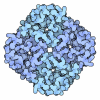+ Open data
Open data
- Basic information
Basic information
| Entry | Database: PDB / ID: 8y8n | |||||||||
|---|---|---|---|---|---|---|---|---|---|---|
| Title | Cryo-EM structure of AQP3 in DDM micelle | |||||||||
 Components Components | Aquaporin-3 | |||||||||
 Keywords Keywords | MEMBRANE PROTEIN / water channel / aquaporin / aquaglyceroporin / glycerol | |||||||||
| Function / homology |  Function and homology information Function and homology informationpositive regulation of immune system process / polyol transmembrane transporter activity / polyol transmembrane transport / Passive transport by Aquaporins / renal water absorption / urea transport / glycerol channel activity / urea transmembrane transporter activity / glycerol transmembrane transport / water transport ...positive regulation of immune system process / polyol transmembrane transporter activity / polyol transmembrane transport / Passive transport by Aquaporins / renal water absorption / urea transport / glycerol channel activity / urea transmembrane transporter activity / glycerol transmembrane transport / water transport / water channel activity / Vasopressin regulates renal water homeostasis via Aquaporins / odontogenesis / response to retinoic acid / response to ischemia / establishment of localization in cell / cell-cell junction / basolateral plasma membrane / cellular response to hypoxia / identical protein binding / plasma membrane / cytoplasm Similarity search - Function | |||||||||
| Biological species |  | |||||||||
| Method | ELECTRON MICROSCOPY / single particle reconstruction / cryo EM / Resolution: 3.12 Å | |||||||||
 Authors Authors | Kozai, D. / Suzuki, S. / Kamegawa, A. / Nishikawa, K. / Suzuki, H. / Fujiyoshi, Y. | |||||||||
| Funding support |  Japan, 2items Japan, 2items
| |||||||||
 Citation Citation |  Journal: Nat Commun / Year: 2025 Journal: Nat Commun / Year: 2025Title: Narrowed pore conformations of aquaglyceroporins AQP3 and GlpF. Authors: Daisuke Kozai / Masao Inoue / Shota Suzuki / Akiko Kamegawa / Kouki Nishikawa / Hiroshi Suzuki / Toru Ekimoto / Mitsunori Ikeguchi / Yoshinori Fujiyoshi /  Abstract: Aquaglyceroporins such as aquaporin-3 (AQP3) and its bacterial homologue GlpF facilitate water and glycerol permeation across lipid bilayers. X-ray crystal structures of GlpF showed open pore ...Aquaglyceroporins such as aquaporin-3 (AQP3) and its bacterial homologue GlpF facilitate water and glycerol permeation across lipid bilayers. X-ray crystal structures of GlpF showed open pore conformations, and AQP3 has also been predicted to adopt this conformation. Here we present cryo-electron microscopy structures of rat AQP3 and GlpF in different narrowed pore conformations. In n-dodecyl-β-D-maltopyranoside detergent micelles, aromatic/arginine constriction filter residues of AQP3 containing Tyr212 form a 2.8-Å diameter pore, whereas in 1-palmitoyl-2-oleoyl-sn-glycero-3-phosphocholine (POPC) nanodiscs, Tyr212 inserts into the pore. Molecular dynamics simulation shows the Tyr212-in conformation is stable and largely suppresses water permeability. AQP3 reconstituted in POPC liposomes exhibits water and glycerol permeability, suggesting that the Tyr212-in conformation may be altered during permeation. AQP3 Y212F and Y212T mutant structures suggest that the aromatic residue drives the pore-inserted conformation. The aromatic residue is conserved in AQP7 and GlpF, but neither structure exhibits the AQP3-like conformation in POPC nanodiscs. Unexpectedly, the GlpF pore is covered by an intracellular loop, but the loop is flexible and not primarily related to the GlpF permeability. Our findings illuminate the unique AQP3 conformation and structural diversity of aquaglyceroporins. | |||||||||
| History |
|
- Structure visualization
Structure visualization
| Structure viewer | Molecule:  Molmil Molmil Jmol/JSmol Jmol/JSmol |
|---|
- Downloads & links
Downloads & links
- Download
Download
| PDBx/mmCIF format |  8y8n.cif.gz 8y8n.cif.gz | 63.1 KB | Display |  PDBx/mmCIF format PDBx/mmCIF format |
|---|---|---|---|---|
| PDB format |  pdb8y8n.ent.gz pdb8y8n.ent.gz | 43.6 KB | Display |  PDB format PDB format |
| PDBx/mmJSON format |  8y8n.json.gz 8y8n.json.gz | Tree view |  PDBx/mmJSON format PDBx/mmJSON format | |
| Others |  Other downloads Other downloads |
-Validation report
| Summary document |  8y8n_validation.pdf.gz 8y8n_validation.pdf.gz | 1.2 MB | Display |  wwPDB validaton report wwPDB validaton report |
|---|---|---|---|---|
| Full document |  8y8n_full_validation.pdf.gz 8y8n_full_validation.pdf.gz | 1.2 MB | Display | |
| Data in XML |  8y8n_validation.xml.gz 8y8n_validation.xml.gz | 22.9 KB | Display | |
| Data in CIF |  8y8n_validation.cif.gz 8y8n_validation.cif.gz | 31.5 KB | Display | |
| Arichive directory |  https://data.pdbj.org/pub/pdb/validation_reports/y8/8y8n https://data.pdbj.org/pub/pdb/validation_reports/y8/8y8n ftp://data.pdbj.org/pub/pdb/validation_reports/y8/8y8n ftp://data.pdbj.org/pub/pdb/validation_reports/y8/8y8n | HTTPS FTP |
-Related structure data
| Related structure data |  39052MC 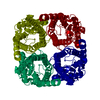 8y8oC 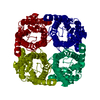 8y8pC 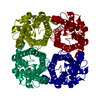 8y8qC 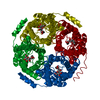 8y8rC  8y8sC 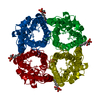 8y8vC 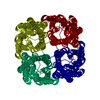 8y8wC  8y8xC M: map data used to model this data C: citing same article ( |
|---|---|
| Similar structure data | Similarity search - Function & homology  F&H Search F&H Search |
- Links
Links
- Assembly
Assembly
| Deposited unit | 
| ||||||||||||||||
|---|---|---|---|---|---|---|---|---|---|---|---|---|---|---|---|---|---|
| 1 | 
| ||||||||||||||||
| Symmetry | Point symmetry: (Schoenflies symbol: C4 (4 fold cyclic)) | ||||||||||||||||
| Noncrystallographic symmetry (NCS) | NCS oper:
|
- Components
Components
| #1: Protein | Mass: 33522.938 Da / Num. of mol.: 1 Source method: isolated from a genetically manipulated source Details: 2-9 His tag 14-19 thrombin digestion site / Source: (gene. exp.)   |
|---|---|
| Has ligand of interest | Y |
| Has protein modification | N |
-Experimental details
-Experiment
| Experiment | Method: ELECTRON MICROSCOPY |
|---|---|
| EM experiment | Aggregation state: PARTICLE / 3D reconstruction method: single particle reconstruction |
- Sample preparation
Sample preparation
| Component | Name: Tetramer of AQP3 in DDM micelle / Type: COMPLEX / Entity ID: all / Source: RECOMBINANT |
|---|---|
| Molecular weight | Experimental value: NO |
| Source (natural) | Organism:  |
| Source (recombinant) | Organism:  |
| Buffer solution | pH: 7.5 |
| Specimen | Embedding applied: NO / Shadowing applied: NO / Staining applied: NO / Vitrification applied: YES |
| Vitrification | Cryogen name: ETHANE |
- Electron microscopy imaging
Electron microscopy imaging
| Microscopy | Model: JEOL CRYO ARM 300 |
|---|---|
| Electron gun | Electron source:  FIELD EMISSION GUN / Accelerating voltage: 300 kV / Illumination mode: FLOOD BEAM FIELD EMISSION GUN / Accelerating voltage: 300 kV / Illumination mode: FLOOD BEAM |
| Electron lens | Mode: BRIGHT FIELD / Nominal defocus max: 2500 nm / Nominal defocus min: 500 nm |
| Image recording | Electron dose: 65.3 e/Å2 / Film or detector model: GATAN K2 SUMMIT (4k x 4k) |
- Processing
Processing
| CTF correction | Type: PHASE FLIPPING AND AMPLITUDE CORRECTION | ||||||||||||||||||||||||
|---|---|---|---|---|---|---|---|---|---|---|---|---|---|---|---|---|---|---|---|---|---|---|---|---|---|
| Symmetry | Point symmetry: C4 (4 fold cyclic) | ||||||||||||||||||||||||
| 3D reconstruction | Resolution: 3.12 Å / Resolution method: FSC 0.143 CUT-OFF / Num. of particles: 153591 / Symmetry type: POINT | ||||||||||||||||||||||||
| Refinement | Highest resolution: 3.12 Å Stereochemistry target values: REAL-SPACE (WEIGHTED MAP SUM AT ATOM CENTERS) | ||||||||||||||||||||||||
| Refine LS restraints |
|
 Movie
Movie Controller
Controller












 PDBj
PDBj